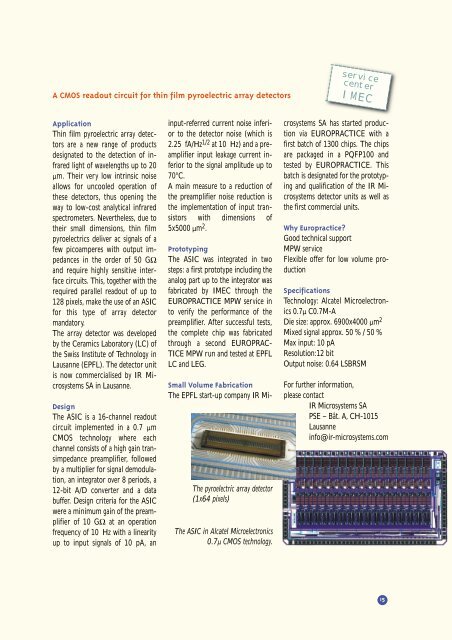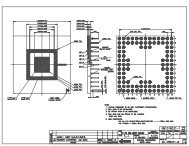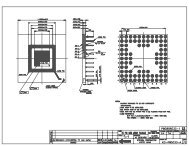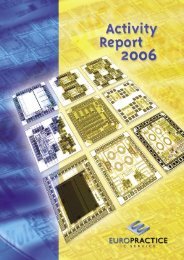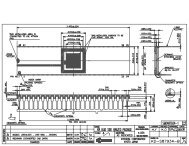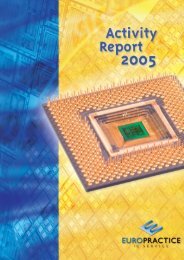Annual report 2000 - Europractice
Annual report 2000 - Europractice
Annual report 2000 - Europractice
You also want an ePaper? Increase the reach of your titles
YUMPU automatically turns print PDFs into web optimized ePapers that Google loves.
A CMOS readout circuit for thin film pyroelectric array detectors<br />
Application<br />
Thin film pyroelectric array detectors<br />
are a new range of products<br />
designated to the detection of infrared<br />
light of wavelengths up to 20<br />
µm. Their very low intrinsic noise<br />
allows for uncooled operation of<br />
these detectors, thus opening the<br />
way to low-cost analytical infrared<br />
spectrometers. Nevertheless, due to<br />
their small dimensions, thin film<br />
pyroelectrics deliver ac signals of a<br />
few picoamperes with output impedances<br />
in the order of 50 GΩ<br />
and require highly sensitive interface<br />
circuits. This, together with the<br />
required parallel readout of up to<br />
128 pixels, make the use of an ASIC<br />
for this type of array detector<br />
mandatory.<br />
The array detector was developed<br />
by the Ceramics Laboratory (LC) of<br />
the Swiss Institute of Technology in<br />
Lausanne (EPFL). The detector unit<br />
is now commercialised by IR Microsystems<br />
SA in Lausanne.<br />
Design<br />
The ASIC is a 16-channel readout<br />
circuit implemented in a 0.7 µm<br />
CMOS technology where each<br />
channel consists of a high gain transimpedance<br />
preamplifier, followed<br />
by a multiplier for signal demodulation,<br />
an integrator over 8 periods, a<br />
12-bit A/D converter and a data<br />
buffer. Design criteria for the ASIC<br />
were a minimum gain of the preamplifier<br />
of 10 GΩ at an operation<br />
frequency of 10 Hz with a linearity<br />
up to input signals of 10 pA, an<br />
input-referred current noise inferior<br />
to the detector noise (which is<br />
2.25 fA/Hz 1/2 at 10 Hz) and a preamplifier<br />
input leakage current inferior<br />
to the signal amplitude up to<br />
70°C.<br />
A main measure to a reduction of<br />
the preamplifier noise reduction is<br />
the implementation of input transistors<br />
with dimensions of<br />
5x5000 µm 2 .<br />
Prototyping<br />
The ASIC was integrated in two<br />
steps: a first prototype including the<br />
analog part up to the integrator was<br />
fabricated by IMEC through the<br />
EUROPRACTICE MPW service in<br />
to verify the performance of the<br />
preamplifier. After successful tests,<br />
the complete chip was fabricated<br />
through a second EUROPRAC-<br />
TICE MPW run and tested at EPFL<br />
LC and LEG.<br />
Small Volume Fabrication<br />
The EPFL start-up company IR Mi-<br />
The pyroelectric array detector<br />
(1x64 pixels)<br />
The ASIC in Alcatel Microelectronics<br />
0.7µ CMOS technology.<br />
---------<br />
---------------<br />
service<br />
center<br />
---------<br />
IMEC<br />
---------------<br />
crosystems SA has started production<br />
via EUROPRACTICE with a<br />
first batch of 1300 chips. The chips<br />
are packaged in a PQFP100 and<br />
tested by EUROPRACTICE. This<br />
batch is designated for the prototyping<br />
and qualification of the IR Microsystems<br />
detector units as well as<br />
the first commercial units.<br />
Why <strong>Europractice</strong>?<br />
Good technical support<br />
MPW service<br />
Flexible offer for low volume production<br />
Specifications<br />
Technology: Alcatel Microelectronics<br />
0.7µ C0.7M-A<br />
Die size: approx. 6900x4000 µm 2<br />
Mixed signal approx. 50 % / 50 %<br />
Max input: 10 pA<br />
Resolution:12 bit<br />
Output noise: 0.64 LSBRSM<br />
For further information,<br />
please contact<br />
IR Microsystems SA<br />
PSE – Bât. A, CH-1015<br />
Lausanne<br />
info@ir-microsystems.com<br />
15


